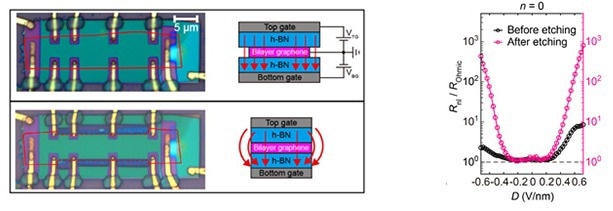A recent study published in Nano Letters sheds new light on the intricate behavior of electron transport in bilayer graphene, highlighting the critical role of edge states and a unique nonlocal transport mechanism.

(Left) Photos and schematic of the edge etching of the bilayer graphene device, before and after the process. (Right) The ratio of measured nonlocal resistance (Rnl) to predicted resistance (ROhmic) before and after edge etching. Image Credit: Pohang University of Science and Technology
Conducted by a team of researchers from Pohang University of Science and Technology (POSTECH) and Japan's National Institute for Materials Science (NIMS), the findings offer deeper insights into the fascinating electronic properties of this material.
The study was led by Professor Gil-Ho Lee and Ph.D. candidate Hyeon-Woo Jeong from POSTECH’s Department of Physics, in collaboration with Dr. Kenji Watanabe and Dr. Takashi Taniguchi of NIMS.
Bilayer graphene, composed of two stacked graphene layers, can utilize externally applied electric fields to adjust its electronic band gap—a crucial property for electron transport. This unique characteristic has garnered interest for its potential applications in “valleytronics,” a promising field for next-generation data processing. Valleytronics leverages the “valley,” a quantum state within an electron’s energy structure that serves as a discrete data storage unit. This approach offers faster and more efficient data handling compared to traditional electronics or spintronics. The tunable band gap of bilayer graphene positions it as a key platform for advancing valleytronics research and device development.
A fundamental principle of valleytronics is the ‘Valley Hall Effect (VHE),’ which directs electron flow through distinct energy states—referred to as “valleys”—in a material. This gives rise to a phenomenon called “nonlocal resistance,” which generates measurable resistance in areas without direct current flow, even in the absence of conduction pathways.
While nonlocal resistance is widely regarded as evidence of the Valley Hall Effect, some researchers argue that impurities at device edges or external influences, such as manufacturing techniques, might also account for the observed signals. This has led to ongoing debate about the origins of VHE.
To identify the precise source of nonlocal resistance in bilayer graphene, the research team from POSCO and NIMS developed a dual-gate graphene device, allowing for controlled manipulation of the band gap. They then compared the electrical properties of naturally formed graphene edges with those processed using Reactive Ion Etching.
The results revealed that nonlocal resistance at naturally formed edges aligned with theoretical predictions, while etched edges displayed resistance values exceeding these predictions by two orders of magnitude. This suggests that the etching process introduced additional conductive pathways unrelated to the Valley Hall Effect, clarifying why earlier studies of bilayer graphene recorded a reduced band gap.
The etching process, a vital step in device fabrication, has not received sufficient scrutiny, particularly regarding its impact on nonlocal transport. Our findings underscore the need to reexamine these considerations and offer crucial insights for advancing valleytronics device design and development.
Hyeon-Woo Jeong, Study First Author, Pohang University of Science and Technology
This research was funded by the National Research Foundation of Korea (NRF), the Ministry of Science and ICT, the Institute for Information & Communications Technology Planning & Evaluation (IITP), the Air Force Office of Scientific Research (AFOSR), the Institute for Basic Science (IBS), the Samsung Science & Technology Foundation, Samsung Electronics Co., Ltd., the Japan Society for the Promotion of Science (JSPS KAKENHI), and the World Premier International Research Center Initiative (WPI).
Journal Reference:
Jeong, H.-W., et al. (2024) Edge Dependence of Nonlocal Transport in Gapped Bilayer Graphene. Nano Letters. doi.org/10.1021/acs.nanolett.4c02660.